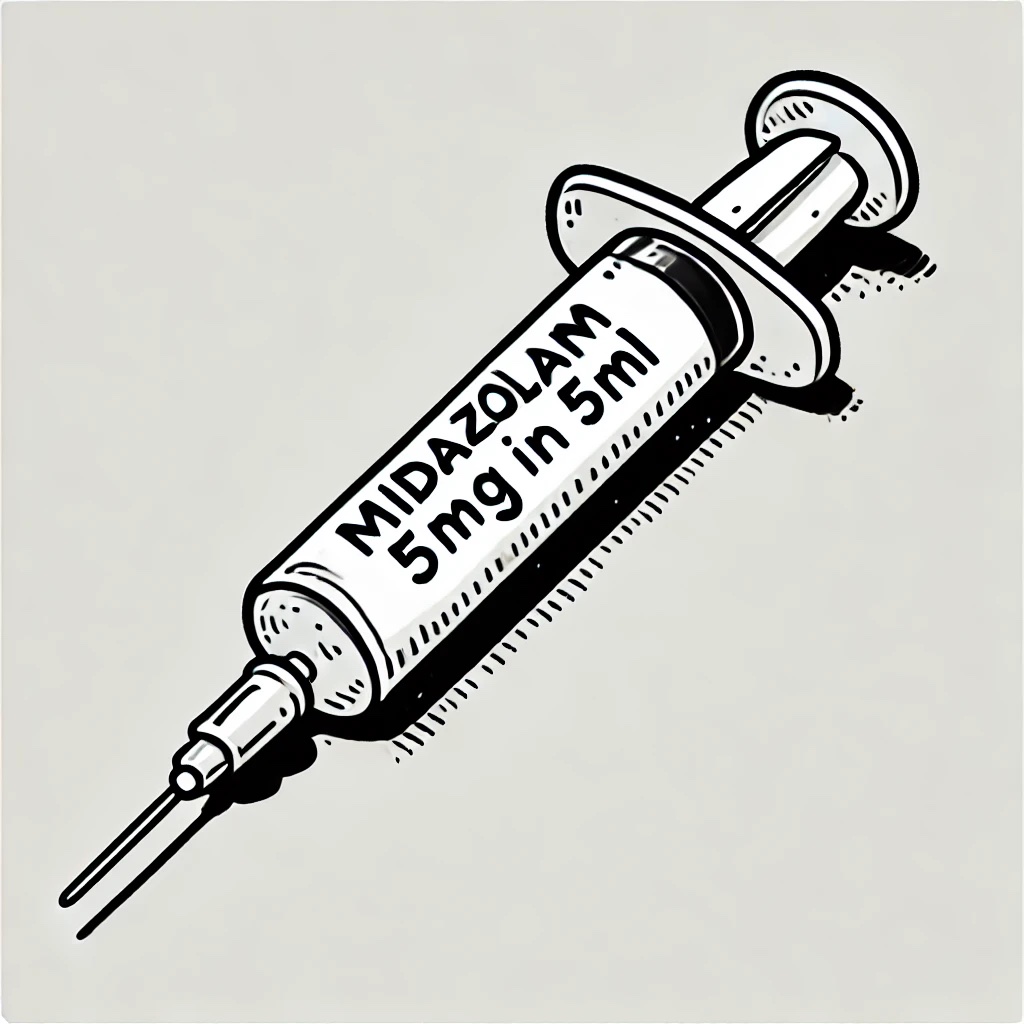1st Line: Midazolam 5mg IV/IM
While a variety of benzodiazepines (benzos) and routes are commonly suggested, midazolam is the only benzo that can be given either IV or IM that is also the same dose via either route. This makes this simple to remember and use in a crisis.
“Give 5 every 5” : The 5mg dose should be rapidly repeated 5 minutely 1-2 times if seizure has not stopped. If it hasn’t worked by then, the seizure is likely to be benzo resistant which occurs as SE duration prolongs due to brain receptor changes. However some patients may have high tolerance due to alcohol or benzo dependence and require bigger doses.
Higher Doses: Some sources recommend higher doses of 0.1mg/kg or even 10mg in adults which may have higher success rates but might result in more airway and breathing complications post seizure termination. By contrast, 5mg is a reasonable first dose but only if it is rapidly repeated as outlined above.
Lower Doses: while some consider smaller IV doses in the elderly or very low bodyweight adults any potential safety benefit from this approach may be outweighed by the substantial risks associated with failure to promptly terminate the seizure. Consequently it is unclear if dose reduction is the optimal strategy in such patients. If lower initial IV doses are considered, even more rapid repeated titration (e.g. 3 minutely) should be utilised if the seizure does not terminate. If IV access is not available dose reduction is not recommended for IM doses as 5mg is already at the lower end of recommended IM doses.
[back to top]
2nd Line: Anti-Epileptic Drug (AED) Infusion
Levetiracetam 60mg/kg up to 4.5g (e.g. in 100ml of Normal Saline) over 5-15 minutes (see below).
OR
Phenytoin 20mg/kg up to 1.5g (e.g. in 250ml of Normal Saline). Maximum infusion rate is 50mg/min so 1g can be delivered over 20 minutes while 1.5g requires 30 minutes. Requires cardiac monitoring.
Key Points:
- Both options are equally effective.
- Levetiracetam is usually preferred due to less interactions/contraindications/adverse effects. Additionally it has the practical advantage of being infused quicker which can assist decision making requiring when to escalate to 3rd line therapy.
- Dose: While Leviteracetam is often used at lower doses such as 20mg/kg for patients who are not actively seizing for seizure prophylaxis, many sources now recommend the higher dose 60mg/kg for SE as a better balancing of benefits and risks given the emergent time critical nature of seizure termination.
- Rate: While the recommended rate has previously been to infuse over 15min, the Therapeutic Guidelines recommend a full 60mg/kg dose over 5min. This echoes paediatric experience where typically a lower 40mg/kg is given over 5min.
- Valproate alternative: While used rarely in my regions of practice (for reasons I do not know), Valproate is also recommended as an equally effective AED infusion alternative to Levetiracetam or Phenytoin. Doses recommended vary from 20-40mg/kg up to 3g over 5-10min.
- Already taking one?: For patients already thought to be taking one of the above agents, seek expert help in choosing an option. In the absence of such advice, it may be safer to choose an agent different to the one they are allegedly taking to avoid toxicity from the addition of a loading dose.
[back to top]
3rd Line: General Anaesthetic
Use a General Anaesthetic (GA) to essentially “shut down the brain” by giving a bolus dose and maintenance infusion. While generally 3rd line therapy, in some cases a GA may be required prior to or simultaneous with 2nd line therapy (see Other Tips).
Best ED options are generally Propofol or Thiopentone.
The following doses are a rough guide only and must be tailored to the patient, their clinical state and co-morbidities:
Propofol 1-2mg/kg induction then titrated maintenance infusion (2-10mg/kg/hr)
OR
Thiopentone 3-5mg/kg then titrated maintenance infusion (3-5mg/kg/hr)
Key Points:
- Consider familiarity: while Thio, the barbiturate, was traditionally recommended, most current ED doctors have had little to no experience with Thio. Consequently, breaking it out in a crisis might be unwise as incorrect dosing can be fatal (especially if the dose is not correctly adjusted to clinical state). If Propofol is most familiar to you, then it is probably your best choice.
- Protect the Airway: Using a GA means you will need to protect the airway, usually via intubation. In locations/situations (e.g. rural/remote sites) without clinicians who have high expertise in intubation, inserting a supra-glottic airway may be a safer alternative.
- Short Acting Paralytic: If intubating use a short acting paralytic (sux rather than roc) to optimise intubation conditions so that it wears off quickly post intubation. This allows ongoing seizure activity to be visually observed and treated with further GA boluses and up-titrated infusion doses. A paralysed patient can still suffer neurological injury from SE continuing in the brain even though it can’t be seen by clinicians.
- Propofol Infusion Syndrome: can occur from high dose propofol infusions (e.g. >4mg/kg/hr for more than 2 hours) which might in itself necessitate additional therapies to allow a reduction in propofol maintenance infusion dose (see Refractory SE).
- Seek expert advice on drug choice, doses, and mode of airway protection if you haven’t already.
[back to top]
Other Tips
- Definition:
- There are various definitions of SE but most modern definitions approximate the following: “a seizure that lasts longer than 5 minutes, or having more than 1 seizure within a 5 minute period, without returning to a normal level of consciousness between episodes.”
- Of note most seizures naturally terminate within 1-2 minutes, so if they have lasted 5 minutes they will need medication management to terminate and 1st line treatment should be started no later than 5 minutes from the onset of seizure activity if possible.
- The Clock is Ticking:
- The aim is to terminate seizures ASAP, but certainly within 30-40 minutes to prevent permanent neurological sequelae.
- In order to achieve this, rapidly escalate therapies and call for the next drugs to be drawn up and brought to the bedside very early, even if you don’t end up using them.
- The longer the patient has been in SE before reaching medical care, the quicker you may have to escalate therapies e.g. if the patient has been seizing for 30 minutes before arrival, you may simply need to skip straight from 1st line (midazolam) to 3rd line therapy (GA) and then give the 2nd line (AED infusion) therapy afterwards.
- Call for help early – i.e. both for on-site team support and for phone/telemedicine expert help.
- Place an IV or IO: Midazolam can be given IM but if an IV line is not obtained rapidly, place an IO for 2nd, 3rd line options.
- Detect & Correct reversible causes:
- It is of critical importance that you urgently take a blood sugar and urgently send off a venous blood gas as hypoglycaemic and hyponatraemic (and more rare hypocalcaemic) seizures may not respond to any therapy without their rapid correction.
- If you suspect late stage pregnancy treat for eclampsia with magnesium sulfate. If unsure (e.g. due to morbid obesity) a quick bedside ultrasound scan should be able to easily confirm such a late stage pregnancy (noting eclampsia doesn’t occur in early pregnancy).
- Collateral history obtained by a team member may help point to a cause e.g. Toxicological.
- See Antidotes for Reversible Causes above
While best efforts were used in the compilation of the above, always consult your own local guidelines and importantly note our disclaimer.
[back to top]

